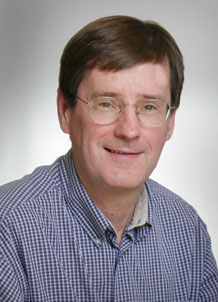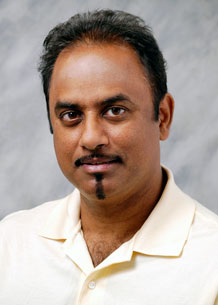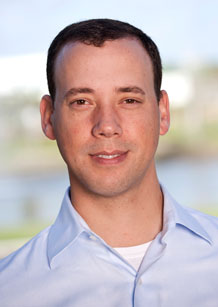

Floor Three: Synthesizing the Future of Scripps Florida
By Michael Tarselli
The mirrored, iridescent blue wall of Building A stretches along the triangular lagoon of the Scripps Florida campus. Peek inside and you may see a big yellow robotic arm, gas tanks being delivered, and scientists sporting blue lab coats and purple gloves. Up on Floor Three, the elevator doors open on a scientific symphony: rotovaps churning, metallic clinks, radios blaring classic rock, and the ever-present hum of a room filled with activity. This is home for Scripps Florida's three synthetic organic chemistry groups.
Led by principal investigators William Roush, Roy Periana, and Glenn Micalizio, the three groups tackle organic synthesis problems, taking simple substances derived from oil, plants, rocks—even the air we breathe—and stitching them together to produce complex structures. Like molecular architects, the 50 chemists that comprise these groups try to answer some of the world's big questions by manipulating substances' "built-in" properties, from boiling point to fragrance. These chemists believe almost anything is possible... with enough time spent at the lab bench.
Using Chemistry to Tackle Disease
A major goal of the Roush group is to make compounds to treat parasitic tropical diseases, such as leishmaniasis or Chagas disease. William Roush, who is a professor in the Department of Chemistry, executive director of the Translational Research Institute Medical Chemistry Division, and associate dean of the Kellogg School of Science and Technology, was one of the first chemists to arrive at Scripps Florida. He hoped to "move [his] research to the biological side," thus taking full advantage of the wealth of top-flight biology colleagues at Scripps Florida.
"Molecular biology isn't a problem in biology," he says. "It's a chemistry problem."
The very first drug–like molecule the group synthesized at Scripps Florida, which wasn't intended to be active, was itself a potent treatment for Chagas. It's now under evaluation by biology collaborators at the University of California, San Diego.
Scripps Florida's diverse faculty also affords the Roush group opportunities to work with several renowned internal collaborators. With Professor John Cleveland, the Roush group makes lactic acid transporter inhibitors, which have recently shown to slow cancer progression in mice tumors. Roush and Assistant Professor Nagi Ayad are studying proteins called kinases in an effort to discover new treatments for Alzheimer's disease.
The rest of the Roush group devotes itself to "classic" synthetic chemistry, a.k.a. the total synthesis (the complete building of complex organic molecules from simpler pieces) of medicinally relevant natural products (single compounds isolated from leaves, fungi, bacteria...even dirt). Many natural products have been found to possess unique properties or enticing new structures.
Roush has developed several boron-based methods to selectively produce single isomers (compounds with the same molecular formula but different structural features) of natural products. This approach (see J. Am. Chem. Soc. 2009, ASAP) can streamline syntheses of potential cancer drugs or enzyme inhibitors.
What especially excites Roush about his craft? "It's an enabling technology," he says. "Chemists can make a molecule that may never have existed to solve a problem."
Finding the Fuel of the Future
The Periana lab tackles energy research. What should we do if oil runs out? How do we "make" energy? Proposed answers have ranged from burning trash to installing solar panels or using clean coal technology.
Any fuel source that replaces petroleum will have to be cheap to produce, easy to store and transport, and be economically competitive, says Periana. He believes the fuel of the future could be methanol.
In contrast to methane — the major component of natural gas that must be liquefied for practical transport and handling and stored in special pressurized tanks — methanol, the product of the oxidation of one methane C-H bond, provides superior handling and storage properties. However, current methanol production methods are themselves energy-intensive.
To address this limitation, the Periana group has developed several late-metal catalysts capable of promoting methane oxidation at lower temperatures, say, 80 degrees Fahrenheit instead of well above 600!
The Periana group discovered recently that, in the mechanism of methane oxidation to methanol, there may be more than one pathway to exploit (J. Am. Chem. Soc. 2009, 11686). The group's previous research employed an electron-poor metal catalyst to activate methane gas toward attack by strong acids to form simple methanol precursors. Using computer calculations, Periana and his colleagues concluded that two alternative pathways could also work: ambiphilic, or little positive or negative charge buildup, and a nucleophilic model – where an electron-rich metal will relay oxygen to methane... a new paradigm for C-H bond activation.
"We're trying to construct an entirely new catalytic system that doesn't exist in the world today," Periana says.
Exploring New Reactions
"There are a lot of ways to make bonds," states Professor Glenn Micalizio, a chemistry trailblazer who arrived at Scripps Florida from Yale University roughly nine months ago.
The Micalizio group explores fundamentally new reactions to assemble molecules in completely novel ways. Towards this goal, he uses titanium reagents to join together unsaturated organic fragments. This reactivity stems from the metal itself: the titanium atom seeks out Π–electrons - those electrons that contribute to multiple bonds between two atoms - and ropes two of them together with itself to form a metallacycle. This "organometallic" compound can be further elaborated to incorporate iodine, bromine, deuterium, or even a third Π-system to provide highly useful molecules.
The Micalizio group recently applied this technology to the first total synthesis of phorbasin C (J. Am. Chem. Soc. 2009, 1392), a sea sponge isolate that could find use as a novel antibacterial. None of the phorbasins or related molecules had ever before been synthesized - even the scientists who isolated these molecules weren't sure of the stereochemistry, or three-dimensional structure, at one of the carbons. Employing methods previously developed in his group, Micalizio and postdoc Todd Macklin not only synthesized the molecule, but were then able to verify the correct structure.
"Every opportunity we have to describe our reactions in a complex setting validates the method and defines its utility beyond the basic science," says Micalizio.
As you walk back to the elevators to return downstairs, turn back and stare down the hallway... Chances are you'll see discussions at a white board, or chemicals being sent for testing. From early morning 'til long after the sun sets, Scripps Florida chemists are working to synthesize a better world.
— Michael Tarselli is a postdoctoral research associate in the Micalizio lab.
Send comments to: mikaono[at]scripps.edu

"Chemists can make a molecule that may never have existed to solve a problem," says Professor William Roush

"We're trying to contract an entirely new catalytic system that doesn't exist in the world today," says Professor Roy Periana.

"There are a lot of ways to make bonds," says Associate Professor Glenn Micalizio
